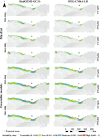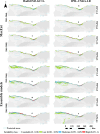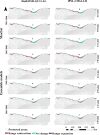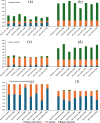Predicting the future impact of climate change on the distribution of species in Egypt's mediterranean ecosystems
- PMID: 40375130
- PMCID: PMC12079925
- DOI: 10.1186/s12870-025-06630-7
Predicting the future impact of climate change on the distribution of species in Egypt's mediterranean ecosystems
Abstract
As climate change accelerates, it may significantly alter species distributions and endanger many species. The use of species distribution modeling (SDM) has become increasingly vital for assessing the likely effects of climatic changes on biodiversity. This approach is especially relevant as our understanding of environmental shifts and their ecological implications deepens. SDMs are frequently employed to forecast future shifts in species' geographic ranges, estimate extinction risks, evaluate the effectiveness of existing conservation areas, and prioritize conservation efforts. The urgency of these assessments is highlighted by the fact that the Mediterranean area is heating up 20% quicker than the universal average. Given that species have varying ecological tolerances and attributes, their biological responses to environmental changes are likely to differ significantly. This study aimed to assess the potential future distribution of three native Mediterranean species- Thymelaea hirsuta (L.) Endl., Ononis vaginalis Vahl, and Limoniastrum monopetalum (L.) Boiss.-under two GCMs of HadGEM3-GC31-LL and IPSL-CM6A-LR for the periods of 2060s and 2080s and two Shared Socioeconomic Pathway (SSP 1-2.6 and SSP5-8.5), comparing the use of MaxEnt and ensemble modelling techniques in predicting the impact of future climatic changes on these species' distribution. The results indicated that there are high similarities and agreement between MaxEnt and the ensemble models' outputs. The two modelling techniques exhibited excellent fits and performance. The distribution range of T. hirsuta and O. vaginalis will expand and migrate to the northwest direction of the Mediterranean coast of Egypt, while L. monopetalum will contract. The insights gained from species distribution modeling could guide future conservation efforts and promote the sustainable use of the studied species in the arid coastal environments of the Mediterranean region. Clinical trial number Not applicable.
Keywords: Biodiversity; Coastal deserts; Distribution models; Ensemble model; Habitat loss; MaxEnt.
© 2025. The Author(s).
Conflict of interest statement
Declarations. Compliance with ethical standards: This work was conducted according to the international and Egyptian legislation. Ethics approval and consent to participate: The authors asked for permission from the local respondents and authorities regarding data collection and publication of the study results. Consent for publication: Not applicable. Competing interests: The authors declare no competing interests.
Figures








Similar articles
-
Remotely sensed data contribution in predicting the distribution of native Mediterranean species.Sci Rep. 2025 Apr 11;15(1):12475. doi: 10.1038/s41598-025-94569-y. Sci Rep. 2025. PMID: 40216846 Free PMC article.
-
Predicting the distributions of Egypt's medicinal plants and their potential shifts under future climate change.PLoS One. 2017 Nov 14;12(11):e0187714. doi: 10.1371/journal.pone.0187714. eCollection 2017. PLoS One. 2017. PMID: 29136659 Free PMC article.
-
Predicting habitat suitability of Illicium griffithii under climate change scenarios using an ensemble modeling approach.Sci Rep. 2025 Mar 20;15(1):9691. doi: 10.1038/s41598-025-92815-x. Sci Rep. 2025. PMID: 40113947 Free PMC article.
-
Research progress on the application of the MaxEnt model in species habitat prediction.Ying Yong Sheng Tai Xue Bao. 2025 Feb 18;36(2):614-624. doi: 10.13287/j.1001-9332.202502.025. Ying Yong Sheng Tai Xue Bao. 2025. PMID: 40370179 Review. English.
-
Does scale matter? A systematic review of incorporating biological realism when predicting changes in species distributions.PLoS One. 2018 Apr 13;13(4):e0194650. doi: 10.1371/journal.pone.0194650. eCollection 2018. PLoS One. 2018. PMID: 29652936 Free PMC article.
References
-
- Handmer J, Honda Y, Kundzewicz ZW, Arnell N, Benito G, Hatfield J, Yamano H. Changes in impacts of climate extremes: human systems and ecosystems. Managing the risks of extreme events and disasters to advance climate change adaptation special report of the intergovernmental panel on climate change. Cambridge, UK, and New York, NY, USA: Cambridge University Press; 2012. pp. 231–90.
-
- IPCC Summary for Policymakers. In. the context of strengthening the global response to the threat of climate change, Sustainable Development, and Efforts to Eradicate Poverty. Geneva, Switzerland: World Meteorological Organization; 2018. p. 32. Global warming of 1.5°C. An IPCC Special Report on the impacts of global warming of 1.5°C above pre-industrial levels and related global greenhouse gas emission pathways.
-
- Azzopardi B, Balzan MV, Cherif S, Doblas-Miranda E, dos Santos M, Dobrinski P, Xoplaki E. Climate and environmental change in the mediterranean basin–current situation and risks for the future. First Mediterranean assessment report; 2020.
-
- Lloret F, de la Riva EG, Pérez-Ramos IM. Climatic events inducing die-off in mediterranean shrublands: are species’ responses related to their functional traits? Oecologia. 2016;180:961–73. - PubMed
MeSH terms
LinkOut - more resources
Full Text Sources
Medical
Research Materials

